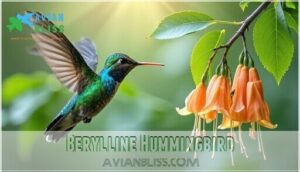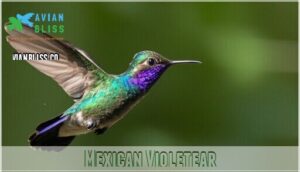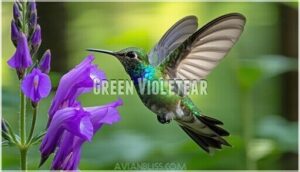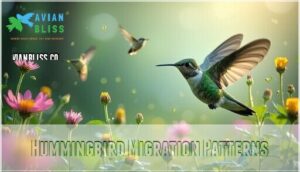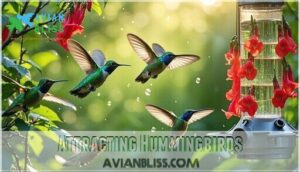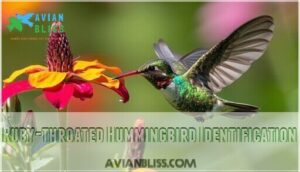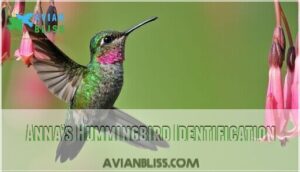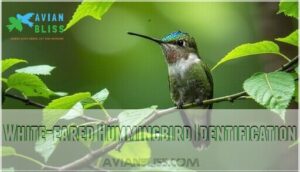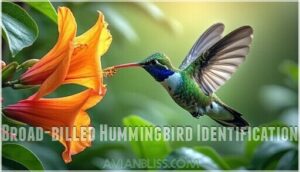This site is supported by our readers. We may earn a commission, at no cost to you, if you purchase through links.

These emerald-backed beauties with their distinctive red throats make up 95% of hummingbird sightings across the state.
However, don’t be surprised if you spot rare western vagrants like Rufous or Anna’s Hummingbirds during migration periods.
These wayward travelers occasionally show up at Michigan feeders, creating excitement among local birders.
The state’s diverse lakeshores and wooded habitats provide ideal stopover points for both residents and migrants.
Hummingbirds in Michigan prefer sugar-water feeders and native flowering plants like bee balm and cardinal flower.
Strategic feeder placement and timing can dramatically increase your chances of attracting these remarkable visitors.
Table Of Contents
Key Takeaways
- You’ll see Ruby-throated Hummingbirds as Michigan’s main residents from May through September, making up 95% of all hummingbird sightings in the state.
- You can attract hummingbirds by planting native flowers like bee balm and cardinal flower, plus setting up sugar-water feeders with a 1:4 sugar-to-water ratio that you’ll need to clean weekly.
- You might spot rare western species like Rufous or Anna’s Hummingbirds during migration periods, though these accidental visitors create exciting but uncommon sighting opportunities.
- You’ll identify male Ruby-throated Hummingbirds by their brilliant red throat patches and metallic green backs, while females show white bellies and lack the distinctive red coloring.
Hummingbirds in Michigan
You’ll find eight documented hummingbird species in Michigan, though only the Ruby-throated Hummingbird appears regularly during breeding season from April through September.
Michigan hosts eight hummingbird species, but only the Ruby-throated calls it home each breeding season.
The remaining seven species—including Rufous, Anna’s, White-eared, Broad-billed, Costa’s, Berylline, and Mexican Violetear hummingbirds—are rare visitors or accidental migrants that create exciting spotting opportunities for dedicated birdwatchers.
Ruby-throated Hummingbird
You’ll recognize Michigan’s most common hummingbird species by the male’s brilliant ruby throat that flashes like a jewel in sunlight.
These tiny michigan birds measure just 3.5 inches but display fierce territorial behavior around feeders.
Their feeding preferences include nectar from tubular flowers and sugar water.
Ruby-throated hummingbird migration spans thousands of miles, with stable conservation status despite habitat challenges.
Rufous Hummingbird
You’ll spot Michigan’s second most common hummingbird species during winter sightings when Rufous Hummingbirds make rare appearances.
These western migration visitors display striking plumage variation with males showing brilliant orange-red feathers. Their aggressive behavior at feeders creates memorable michigan birds encounters.
Rufous Hummingbirds are known as key pollinators, aiding in plant reproduction.
Watch for hybridization risks when multiple hummingbird species overlap, making proper identification of these exceptional rare species essential for accurate hummingbird sightings.
Anna’s Hummingbird
Anna’s Hummingbird stands out as a rare visitor to Michigan, despite being a western native of the Pacific Coast.
You’ll recognize males by their stunning magenta gorget that shimmers in sunlight. These medium-sized hummingbirds prefer suburban gardens and parks.
Michigan hummingbird sightings remain exceptional, with only two documented records since 2010, making identification tips essential for spotting this rare species. Males are known for their elaborate aerial dive displays.
White-eared Hummingbird
The White-eared Hummingbird stands out among Michigan’s hummingbird species with its distinctive white eyestripe and red bill tipped in black.
This tiny wanderer from Mexico’s mountains weighs just 3-4 grams yet makes an extraordinary journey northward.
Michigan sightings remain exceptionally rare, with only one confirmed record.
Its distinguishing features include iridescent violet coloring and stocky build for easier hummingbird identification, making it a notable species with its distinctive white eyestripe.
Broad-billed Hummingbird
Although Broad-billed Hummingbirds call the southwestern habitat of Arizona and Mexico home, you’ll find rare sightings in Michigan that make every birdwatcher’s heart skip a beat.
This hummingbird species stands out with its distinctive bill morphology and emerald plumage.
Key features for hummingbird identification include:
- Vivid red bill with black tip
- Sapphire throat in males
- Emerald-green body coloration
Their feeding preferences focus on nectar and insects, while their conservation status remains stable in native ranges despite occasional Broadbilled Hummingbird appearances during bird identification efforts in Michigan’s birdwatching community.
Michigan Hummingbird Species
You’ll find eight documented hummingbird species in Michigan’s official bird records, though only the Ruby-throated Hummingbird appears regularly during breeding season.
The remaining seven species—including Costa’s, Berylline, Mexican Violetear, and Green Violetear—represent rare visitors or accidental vagrants with just a handful of confirmed sightings across the state’s birding history, highlighting the importance of rare visitors.
Costa’s Hummingbird
Discovering Costa’s Hummingbird in Michigan feels like finding a desert jewel in unexpected territory.
This accidental visitor from southwestern origins ranks among the rarest Michigan hummingbird species you’ll encounter.
Its purple iridescence makes identification unforgettable during birdwatching in Michigan adventures.
| Feature | Details |
|---|---|
| Size | 3 grams, extremely small |
| Male Coloration | Violet crown, purple-red throat |
| Conservation Status | Species of Least Concern |
| Michigan Status | Extremely rare accidental visitor |
Berylline Hummingbird
You’ll find the Berylline Hummingbird among Michigan’s rarest visitors.
This stunning species measures 3.1-3.9 inches with brilliant green heads and chestnut wings.
Berylline Identification relies on their distinctive red-orange bills and turquoise throats.
These Hummingbirds prefer oak woodlands in their native Mexico, making Berylline Sightings exceptional treats for birdwatching in Michigan enthusiasts.
- Berylline Habitat: Oak woodlands and shade-coffee plantations create their preferred environment
- Berylline Diet: Nectar dependency drives their territorial feeding behavior patterns
- Berylline Conservation: Stable populations face potential habitat loss from development pressures
- Berylline Identification: Males display more vibrant breeding season coloration than females
- Berylline Sightings: Extremely rare Michigan appearances make each observation historically significant
Mexican Violetear
Mexican Violetear hummingbirds display stunning iridescent plumage with metallic green and violet-blue coloration.
These rare visitors from Central America occasionally appear in Michigan during unexpected migration events. Their habitat preferences include mountainous forests, contrasting with Michigan’s typical bird habitats.
Conservation status remains stable in their native range.
Birdwatching enthusiasts should watch for their distinctive violet ear patches and nomadic behavior patterns. To attract more birds, consider native plant selection for your garden.
Green Violetear
You’ll spot Green Violetear Hummingbirds through rare sightings in Michigan’s southeastern regions.
These nomadic behavior specialists showcase brilliant green plumage details with distinctive blue-violet ear patches.
Their habitat preference includes dense forests and flower banks.
Birdwatching enthusiasts treasure encounters with this tropical species.
Conservation status remains stable in native ranges, though Michigan appearances stay exceptional for dedicated hummingbird observers.
Hummingbird Migration Patterns
You’ll witness one of nature’s most remarkable journeys when hummingbirds arrive in Michigan each spring, traveling over 500 miles from their wintering grounds in Central and South America.
These tiny migrants follow precise timing patterns, with Ruby-throated Hummingbirds typically reaching the state between late April and early May, while rare western species like Rufous Hummingbirds occasionally appear during unexpected seasonal movements, showcasing their incredible ability to navigate and thrive in new environments with precise timing patterns.
Ruby-throated Hummingbird Migration
Migration triggers send Ruby-throated Hummingbirds on epic journeys twice yearly.
These tiny aerial athletes embark on death-defying 2,000-mile odysseys that humble even the most seasoned travelers.
These tiny travelers navigate from breeding grounds in Michigan to Central American wintering areas, covering over 2,000 miles.
Climate impact affects their timing, while stopover habitats provide essential refueling stations.
Bird migration patterns reveal they cross the Gulf of Mexico non-stop, facing significant migration challenges during this demanding voyage, which includes a journey of over 2,000 miles and requires precise timing, and presents an incredible test of endurance, especially the Gulf of Mexico.
Rufous Hummingbird Migration
The Rufous Hummingbird undertakes one of nature’s most remarkable journeys, traveling over 3,000 miles from Western Breeding grounds to Wintering Grounds in Mexico. These Migration Distance champions rarely appear in Michigan Sightings, making each encounter special.
Their routes are influenced by food availability.
Key migration patterns include:
- Following Pacific flyway routes through Rocky Mountains
- Timing coincides with wildflower blooms and alpine meadows
- Climate Impact affects traditional migration timing
- Bird migration occurs between May and September, with a focus on complete concepts of migration patterns.
Peak Migration Seasons
You’ll witness peak hummingbird migration in Michigan during late April through early May when Ruby-throated hummingbirds arrive from their Great Lakes crossing.
Environmental factors like temperature and flower blooms trigger these precise migration patterns.
Weather conditions can shift arrival timing by several days, affecting stopover habitats throughout the state, and migration challenges include finding adequate nectar sources during unpredictable spring weather.
Migration Tracking Methods
You can follow hummingbird migration through cutting-edge technologies that reveal their incredible journeys.
Michigan’s Motus Array tracks Ruby-throated hummingbird movements across the Great Lakes region using sophisticated methods.
Modern tracking systems include:
- Radio Telemetry – Miniature transmitters monitor real-time flight paths
- Banding Studies – Metal bands help researchers identify individual birds
- Citizen Science – GPS trackers and public reporting enhance migration data
Attracting Hummingbirds
You can transform your yard into a hummingbird haven by combining the right plants, feeders, and garden design elements.
Creating an effective hummingbird habitat requires understanding these tiny birds’ specific needs for nectar sources, perching spots, and safe nesting areas.
Planting Native Plants
Native plants offer the best foundation for attracting hummingbirds to your Michigan garden.
Ruby-throated Hummingbirds prefer red tubular flowers like Cardinal Flower and Bee Balm. Your local nurseries stock these Michigan-adapted species that require less maintenance than exotic alternatives.
Consider purchasing Michigan native plants for your garden. Focus on soil considerations when selecting hummingbird plants, ensuring proper drainage for ideal native plant establishment and long-term garden design success.
Using Nectar Feeders
Proper hummingbird feeders become game-changers for attracting Michigan’s ruby-throated visitors.
Mix one part white sugar with four parts water for ideal sugar concentration. Strategic feeder placement near shelter, combined with weekly feeder cleaning, guarantees healthy birds.
To further attract hummingbirds, plant native flowers with tubular blossoms. Create ant prevention barriers and bee deterrents around feeders.
Fresh hummingbird nectar every few days keeps your sugar water irresistible to these tiny jewels.
Creating Hummingbird-Friendly Gardens
While feeders provide reliable nutrition, your hummingbird garden needs strategic design for maximum appeal.
Plant Native Plants like bee balm and cardinal flower in clusters for visual impact. Position hummingbird feeders near flower beds but allow clear flight paths.
Add Water Sources like shallow fountains or misters. Consider incorporating Michigan native plant species to further enhance your garden’s appeal.
Create Shelter Options with dense shrubs and maintain proper Insect Control without harmful pesticides in your birdfriendly gardens.
Tips for Attracting Hummingbirds
Beyond thoughtful garden design, specific strategies will transform your yard into a hummingbird haven. Attracting hummingbirds requires attention to detail and consistent care.
Many enthusiasts find success using specialized feeder products designed for ideal hummingbird feeding.
Essential tips for success:
- Feeder Placement – Position hummingbird feeders 10-15 feet from dense shrubs where rubythroated hummingbirds can quickly escape predators while maintaining clear flight paths to sugar solution sources.
- Water Source – Install shallow fountains or misters creating fine droplets that hummingbirds prefer for bathing and drinking in their Michigan habitats.
- Avoiding Pesticides – Eliminate chemical treatments that harm insects hummingbirds need for protein while maintaining organic hummingbird garden practices.
Hummingbird Identification
You can identify Michigan’s hummingbirds by examining key physical features like throat color, size, and wing patterns.
Males typically display bright, iridescent throat patches called gorgets, while females show more subdued coloring with white or pale underparts.
Ruby-throated Hummingbird Identification
Spotting a Ruby-throated Hummingbird in Michigan is thrilling! Look for its metallic-green back and a Male Throat shimmering ruby red.
Females have softer, white bellies and brownish wings. Juvenile Markings often mimic females but lack full iridescence.
These hummingbirds, 2.8 to 3.5 inches, showcase agile Flight Patterns, darting between blooms.
Here’s a quick comparison:
| Feature | Male | Female | Juvenile |
|---|---|---|---|
| Throat Color | Ruby red | White | Dull white |
| Back Color | Metallic green | Metallic green | Metallic green |
| Belly Color | White | White | White |
| Size | 2.8-3.5 inches | 2.8-3.5 inches | 2.8-3.5 inches |
| Flight Behavior | Agile, territorial | Agile, less territorial | Erratic, playful |
Rufous Hummingbird Identification
Rufous Hummingbird identification in Michigan requires attention to plumage variations and molting patterns.
Males display brilliant orange-red throats and rufous backs, while females show green backs with rufous flanks.
Juvenile ID proves challenging due to similar female coloring, and bird identification apps help distinguish regional differences.
Hybridization risks among Michigan’s hummingbird species during migration seasons must also be considered, as they can impact accurate identification.
Anna’s Hummingbird Identification
Anna’s Hummingbird stands out with its vibrant magenta gorget and iridescent crown that shimmer in sunlight.
You’ll notice its stockier build compared to other hummingbird species identification features in Michigan. Bird identification apps help distinguish its distinctive rose-pink throat from similar species.
Key identification markers include:
- Glossy green back with rose-pink head coloration
- Medium size measuring 3.5-4 inches in length
- Distinctive vocalizations including sharp chirping calls
White-eared Hummingbird Identification
White-eared Hummingbirds stand out with their distinctive white facial stripe behind the eye – your best identification clue.
You’ll notice their red bill with black tip and violet crown on males. These rare Michigan visitors measure 9-10 cm, smaller than Anna’s but stocky.
Watch for green backs and territorial behavior near mountain forests during brief appearances.
| Feature | Male | Female |
|---|---|---|
| Facial Stripe | Prominent white eyestripe | White eyestripe present |
| Crown Color | Iridescent violet | Green crown |
| Bill Details | Red with black tip | Red with black tip |
| Size Comparison | 9-10 cm, stocky build | 9-10 cm, similar build |
Broad-billed Hummingbird Identification
Identifying Michigan’s rarest visitor requires keen observation skills.
You’ll notice the Broadbilled hummingbird’s distinctive red-orange bill shape and brilliant blue-green plumage details immediately.
Males display sapphire throats that shimmer in sunlight.
Check range maps before claiming a sighting—these rare birds typically stay in southwestern habitats.
Listen for their distinctive vocalizations while scanning woodland edges and gardens for positive hummingbird identification.
These birds can enter a torpor state to conserve energy, which is a crucial aspect of their torpor state and overall behavior, including their ability to survive in various southwestern habitats with unique brilliant blue-green plumage.
Frequently Asked Questions (FAQs)
How long do Michigan hummingbirds typically live?
Like tiny jeweled warriors dancing through time, you’ll find most hummingbirds live surprisingly brief lives.
In the wild, they typically survive 3-5 years, though some exceptional individuals may reach 8-10 years with ideal conditions.
What predators threaten hummingbirds in Michigan?
You’ll find cats, hawks, praying mantises, and spiders pose the biggest threats to your backyard hummingbirds.
Snakes occasionally raid nests, while larger birds like blue jays steal eggs and attack young chicks.
Do hummingbirds in Michigan build multiple nests?
Yes, you’ll find that Ruby-throated hummingbirds often construct multiple nests during their breeding season.
They typically build two to three nests per year, reusing materials and selecting new locations for each successive brood attempt, which can be considered a complete process of nest construction, and also involves breeding season activities.
How fast can Michigan hummingbirds fly?
Michigan’s hummingbirds reach impressive speeds during flight. You’ll see them zoom forward at 30 mph in regular flight, but they’re capable of diving at breathtaking speeds up to 60 mph when necessary.
What diseases commonly affect Michigan hummingbirds?
Tiny jeweled warriors face invisible enemies daily.
You’ll encounter fungal infections, bacterial diseases, and parasitic mites affecting Michigan’s hummingbirds.
Common threats include candidiasis, salmonella, and feather mites that compromise their delicate immune systems and flight capabilities.
Conclusion
While massive Great Lakes stretch endlessly across Michigan’s horizon, tiny hummingbirds create equally impressive spectacles through their remarkable journeys.
You’ve discovered that hummingbirds in Michigan offer extraordinary viewing opportunities, from common Ruby-throated residents to rare western vagrants.
Success depends on proper timing, strategic feeder placement, and native plant selection.
Whether you’re tracking migration patterns or identifying species characteristics, Michigan’s diverse habitats provide excellent hummingbird watching experiences.
Start preparing your garden now for next season’s arrivals, utilizing proper timing to maximize your chances of spotting these birds.
- https://www.nature.com/articles/s41598-021-97889-x
- https://michigannature.wordpress.com/2013/04/30/species-spotlight-four-hummingbirds-occasionally-found-in-michigan/
- https://partnersinflight.org/feisty-and-fierce-but-under-threat-rufous-hummingbird-survival-depends-on-collaborations-across-canadian-usa-and-mexican-borders/
- https://www.michiganaudubon.org/about-us/chapters/
- https://animaldiversity.org/accounts/Calypte_anna/


